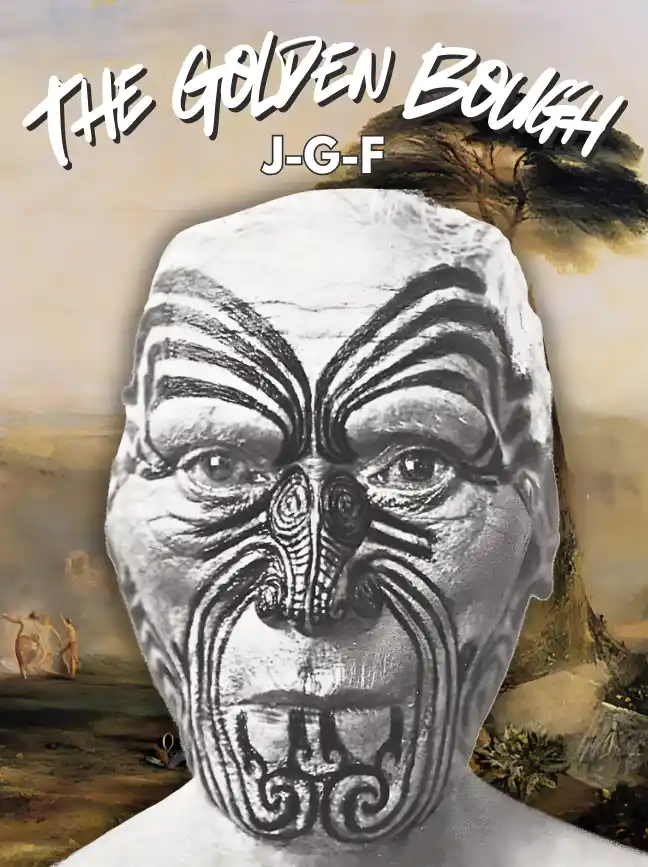CHAPTER 1
BETWEEN HEAVEN AND EARTH
i
WE have travelled far since we turned our backs on Nemi and set forth in quest of the secret of the Golden Bough. We now enter on the last stage of our journey. The reader may remember that at the outset two questions were proposed: Why had the priest of Aricia to slay his predecessor? And why, before doing so, had he to pluck the Golden Bough? Of these two questions the first has now been answered. The priest of Aricia, if I am right, was one of those sacred kings or human divinities on whose life the welfare of the community and even the course of nature in general are believed to be intimately dependent. It does not appear that the subjects or worshippers of such a spiritual potentate form to themselves any very clear notion of the exact relationship in which they stand to him; probably their ideas on the point are vague and fluctuating, and we should err if we attempted to define the relationship with logical precision. All that the people know, or rather imagine, is that somehow they themselves, their cattle, and their crops are mysteriously bound up with their divine king, so that according as he is well or ill the community is healthy or sickly, the flocks and herds thrive or languish with disease, and the fields yield an abundant or a scanty harvest.
The worst evil which they can conceive of is the natural death of their ruler, whether he succumb to sickness or old age, for in the opinion of his followers such a death would entail the most disastrous consequences on themselves and their possessions; fatal epidemics would sweep away man and beast, the earth would refuse her increase, nay the very frame of nature itself might be dissolved. To guard against these catastrophes it is necessary to put the king to death while he is still in the full bloom of his divine manhood, in order that his sacred life, transmitted in unabated force to his successor, may renew its youth, and thus by successive transmissions through a perpetual line of vigorous incarnations may remain eternally fresh and young, a pledge and security that men and animals shall in like manner
renew their youth by a perpetual succession of generations, and that seedtime and harvest, and summer and winter, and rain and sunshine shall never fail. That, if my conjecture is right, was why the priest of Aricia, the King of the Wood at Nemi, had regularly to perish by the sword of his successor. But we have still to ask, What was the Golden Bough? and why had each candidate for the Arician priesthood to pluck it before he could slay the priest?
The priest of Aricia and the Golden Bough.
What was the Golden Bough?
It will be well to begin by noticing two of those rules or taboos by which, as we have seen, the life of divine kings or priests is regulated. The first of the rules is that the divine personage may not touch the ground with his foot. This rule was observed by the supreme pontiff of the Zapotecs in Mexico; he profaned his sanctity if he so much as touched the ground with his foot. Montezuma, emperor of Mexico, never set foot on the ground; he was always carried on the shoulders of noblemen, and if he lighted anywhere they laid rich tapestry for him to walk upon. For the Mikado of Japan to touch the ground with his foot was a shameful degradation; indeed, in the sixteenth century, it was enough to deprive him of his office. Outside his palace he was carried on men’s shoulders; within it he walked on exquisitely wrought mats. The king and queen of Tahiti might not touch the ground anywhere but within their hereditary domains; for the ground on which they trod became sacred. In travelling from place to place they were carried on the shoulders of sacred men. They were always accompanied by several pairs of these sanctified attendants; and when it became necessary to change their bearers, the king and queen vaulted on to the shoulders of their new bearers without letting their feet touch the ground. It was an evil omen if the king of Dosuma touched the ground, and he had to perform an expiatory ceremony. Within his palace the king of Persia walked on carpets on which no one else might tread; outside of it he was never seen on foot but only in a chariot or on horseback. In old days the king of Siam never set foot upon the earth, but was carried on a throne of gold from place to place.
Formerly neither the kings of Uganda, nor their mothers, nor their queens might walk on foot outside of the spacious enclosures in which they lived.
Whenever they went forth they were carried on the shoulders of men of the Buffalo clan, several of whom accompanied any of these royal personages on a journey and took it in turn to bear the burden. The king sat astride the bearer’s neck with a leg over each shoulder and his feet tucked under the bearer’s arms. When one of these royal carriers grew tired he shot the king on to the shoulders of a second man without allowing the royal feet to touch the ground. In this way they went at a great pace and travelled long distances in a day, when the king was on a journey. The bearers had a special hut in the king’s enclosure in order to be at hand the moment they were wanted. Among the Ibo people about Awka, in Southern Nigeria, the priest of the Earth has to observe many taboos; for example, he may not see a corpse, and if he meets one on the road he must hide his eyes with his wristlet. He must abstain from many foods, such as eggs, birds of all sorts, mutton, dog, bush-buck, and so forth. He may neither wear nor touch a mask, and no masked man may enter his house. If a dog enters his house, it is killed and thrown out. As priest of the Earth he may not sit on the bare ground, nor eat things that have fallen on the ground, nor may earth be thrown at him. According to ancient Brahmanic ritual a king at his inauguration trod on a tiger’s skin and a golden plate; he was shod with shoes of boar’s skin, and so long as he lived thereafter he might not stand on the earth with his bare feet.
Sacred kings and priests forbidden to touch the ground with
their feet.
But besides persons who are permanently sacred or tabooed and are therefore permanently forbidden to touch the ground with their feet, there are others who enjoy the character of sanctity or taboo only on certain occasions, and to whom accordingly the prohibition in question only applies at the definite seasons during which they exhale the odour of sanctity. Thus among the Kayans or Bahaus of Central Borneo, while the priestesses are engaged in the performance of certain rites they may not step on the ground, and boards are laid for them to tread on. At a funeral ceremony observed by night among the Michemis, a Tibetan tribe near the northern frontier of Assam, a priest fantastically bedecked with tiger’s teeth, many- coloured plumes, bells, and shells, executed a wild dance for the purpose of
exorcising the evil spirits; then all fires were extinguished and a new light was struck by a man suspended by his feet from a beam in the ceiling; ‘he did not touch the ground’, we are told, ‘in order to indicate that the light came from heaven.’ Again, newly born infants are strongly tabooed; accordingly in Loango they are not allowed to touch the earth. Among the Iluvans of Malabar the bridegroom on his wedding-day is bathed by seven young men and then carried or walks on planks from the bathing-place to the marriage booth; he may not touch the ground with his feet. With the Dyaks of Landak and Tajan, two districts of Dutch Borneo, it is a custom that for a certain time after marriage neither bride nor bridegroom may tread on the earth. Warriors, again, on the war-path are surrounded, so to say, by an atmosphere of taboo; hence some Indians of North America might not sit on the bare ground the whole time they were out on a warlike expedition. In Laos the hunting of elephants gives rise to many taboos; one of them is that the chief hunter may not touch the earth with his foot.
Accordingly, when he alights from his elephant, the others spread a carpet of leaves for him to step upon. German wiseacres recommended that when witches were led to the block or the stake, they should not be allowed to touch the bare earth, and a reason suggested for the rule was that if they touched the earth they might make themselves invisible and so escape. The sagacious author* of The Striped-petticoat Philosophy in the eighteenth century ridicules the idea as mere silly talk. He admits, indeed, that the women were conveyed to the place of execution in carts; but he denies that there is any deep significance in the cart, and he is prepared to maintain this view by a chemical analysis of the timber of which the cart was built. To clinch his argument he appeals to plain matter of fact and his own personal experience. Not a single instance, he assures us with apparent satisfaction, can be produced of a witch who escaped the axe or the fire in this fashion.
‘I have myself,’ says he, ‘in my youth seen divers witches burned, some at Arnstadt, some at Ilmenau, some at Schwenda, a noble village between Arnstadt and Ilmenau, and some of them were pardoned and beheaded before being burned. They were laid on the earth in the place of execution and beheaded like any other poor sinner; whereas if they could have escaped by touching the earth, not one of them would have failed to do so’.
Certain persons on certain occasions forbidden to touch the
ground with their feet.
Apparently holiness, magical virtue, taboo, or whatever we may call that mysterious quality which is supposed to pervade sacred or tabooed persons, is conceived by the primitive philosopher as a physical substance or fluid, with which the sacred man is charged just as a Leyden jar* is charged with electricity; and exactly as the electricity in the jar can be discharged by contact with a good conductor, so the holiness or magical virtue in the man can be discharged and drained away by contact with the earth, which on this theory serves as an excellent conductor for the magical fluid. Hence in order to preserve the charge from running to waste, the sacred or tabooed personage must be carefully prevented from touching the ground; in electrical language he must be insulated, if he is not to be emptied of the precious substance or fluid with which he, as a vial, is filled to the brim. And in many cases apparently the insulation of the tabooed person is recommended as a precaution not merely for his own sake but for the sake of others; for since the virtue of holiness or taboo is, so to say, a powerful explosive which the smallest touch may detonate, it is necessary in the interest of the general safety to keep it within narrow bounds, lest breaking out it should blast, blight, and destroy whatever it comes into contact with.
Sacred or tabooed persons apparently thought to be charged
with a mysterious virtue like a fluid, which will run to waste or
explode if it touches the ground.
ii
The second rule to be here noted is that the sun may not shine upon the divine person. This rule was observed both by the Mikado and by the pontiff of the Zapotecs. The latter ‘was looked upon as a god whom the earth was not worthy to hold, nor the sun to shine upon’. The Japanese would not allow that the Mikado should expose his sacred person to the open air, and the sun was not thought worthy to shine on his head. The Indians of Granada, in South America, ‘kept those who were to be rulers or commanders, whether men or women, locked up for several years when they were children, some of them seven years, and this so close that they were not to see the sun, for if they should happen to see it they forfeited
their lordship, eating certain sorts of food appointed; and those who were their keepers at certain times went into their retreat or prison and scourged them severely.’ Thus, for example, the heir to the throne of Bogota, who was not the son but the sister’s son of the king, had to undergo a rigorous training from his infancy: he lived in complete retirement in a temple, where he might not see the sun nor eat salt nor converse with a woman: he was surrounded by guards who observed his conduct and noted all his actions: if he broke a single one of the rules laid down for him, he was deemed infamous and forfeited all his rights to the throne. So, too, the heir to the kingdom of Sogamoso, before succeeding to the crown, had to fast for seven years in the temple, being shut up in the dark and not allowed to see the sun or light. The prince who was to become Inca of Peru had to fast for a month without seeing light. On the day when a Brahman student of the Veda took a bath, to signify that the time of his studentship was at an end, he entered a cow-shed before sunrise, hung over the door a skin with the hair inside, and sat there; on that day the sun should not shine upon him.
Sacred persons not allowed to see the sun.
Again, women after childbirth and their offspring are more or less tabooed all the world over; hence in Corea the rays of the sun are rigidly excluded from both mother and child for a period of twenty-one or a hundred days, according to their rank, after the birth has taken place.
Among some of the tribes on the north-west coast of New Guinea a woman may not leave the house for months after childbirth. When she does go out, she must cover her head with a hood or mat; for if the sun were to shine upon her, it is thought that one of her male relations would die. Again, mourners are everywhere taboo; accordingly in mourning the Ainos of Japan wear peculiar caps in order that the sun may not shine upon their heads. During a solemn fast of three days the Indians of Costa Rica eat no salt, speak as little as possible, light no fires, and stay strictly indoors, or if they go out during the day they carefully cover themselves from the light of the sun, believing that exposure to the sun’s rays would turn them black. On Yule Night it has been customary in parts of Sweden from time immemorial to go on pilgrimage, whereby people learn many secret things and know what is to happen in the coming year. As a preparation for this pilgrimage,
‘some secrete themselves for three days previously in a dark cellar, so as to be shut out altogether from the light of heaven. Others retire at an early hour of the preceding morning to some out-of-the-way place, such as a hay- loft, where they bury themselves in the hay, that they may neither see nor hear any living creature; and here they remain, in silence and fasting, until after sundown; whilst there are those who think it sufficient if they rigidly abstain from food on the day before commencing their wanderings. During this period of probation a man ought not to see fire, but should this have happened, he must strike a light with flint and steel, whereby the evil that would otherwise have ensued will be obviated.’ During the sixteen days that a Pima Indian is undergoing purification for killing an Apache he may not see a blazing fire.
Tabooed persons not allowed to see the sun.
Certain persons forbidden to see fire.
Acarnanian peasants* tell of a handsome prince called Sunless, who would die if he saw the sun. So he lived in an underground palace on the site of the ancient Oeniadae, but at night he came forth and crossed the river to visit a famous enchantress who dwelt in a castle on the further bank. She was loth to part with him every night long before the sun was up, and as he turned a deaf ear to all her entreaties to linger, she hit upon the device of cutting the throats of all the cocks in the neighbourhood. So the prince, whose ear had learned to expect the shrill clarion of the birds as the signal of the growing light, tarried too long, and hardly had he reached the ford when the sun rose over the Aetolian mountains, and its fatal beams fell on him before he could regain his dark abode.
The story of Prince Sunless.






